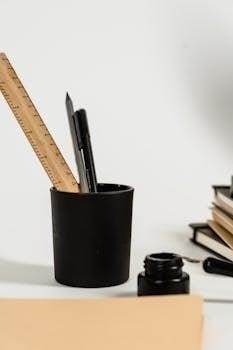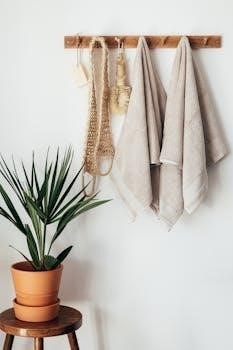loom pot holder instructions

Materials Needed
To begin, you’ll need a hand or floor loom, which is ideal for potholders. Yarn options include cotton, wool, and blends for durability and warmth. A matching thread is needed, along with a tapestry or blunt-tipped needle.
Loom Type⁚ Hand or Floor Loom
For crafting potholders, a handloom or floor loom is perfectly suited. These types of looms provide the necessary structure for weaving, ensuring that the loops are properly secured during the process. The choice between a handloom and a floor loom often depends on personal preference and the scale of your weaving endeavors. Handlooms are more compact, making them suitable for smaller projects like potholders, while floor looms offer a larger weaving area and can accommodate bigger projects. Regardless of which one you choose, both types will allow you to create functional and decorative potholders with ease. The key is to select a loom that feels comfortable and manageable for your weaving style, ensuring a pleasurable crafting experience.
Yarn Options⁚ Cotton, Wool, Blends
When selecting yarn for your potholders, consider options like cotton, wool, or blends. Cotton yarn is a popular choice for its durability, absorbency, and heat resistance, making it ideal for handling hot items. Wool yarn offers excellent insulation and a soft texture, providing warmth and protection. Blends, which combine different fibers, can offer the benefits of both materials, such as the durability of cotton with the warmth of wool. The best yarn option will depend on your personal preferences and the specific characteristics you are looking for in your potholders. Always choose a yarn that is both sturdy and comfortable to work with. Remember, the yarn you select will directly impact the quality and functionality of your finished potholder.
Thread⁚ Matching Color to Yarn
Selecting the right thread is crucial for a polished and cohesive look for your potholder. Always choose a thread color that closely matches the yarn you’ve selected for weaving. This will help ensure that any visible stitches or securing points blend seamlessly into the overall fabric, creating a more professional and aesthetically pleasing final product. A contrasting thread could draw unwanted attention to these areas and distract from the overall design of the potholder. Using a matching thread will maintain the visual integrity of your project and create a harmonious color scheme. The thread should also be durable and strong enough to withstand regular use and washing, adding to the long-term quality of the potholder.
Needle⁚ Tapestry or Blunt-tipped
A tapestry or blunt-tipped needle is essential for weaving potholders on a loom; These types of needles have a large eye, which makes threading yarn easier, and a rounded or blunt point, which helps to prevent snagging or splitting the yarn fibers during the weaving process. The blunt tip also reduces the risk of accidentally piercing your fingers or the loops on the loom, making the weaving process safer and more comfortable. Using a sharp needle is not recommended because it can damage the loops and make the weaving more difficult. Opting for a tapestry or blunt-tipped needle ensures a smoother and more efficient weaving experience, resulting in a well-crafted and durable potholder.

Setting Up the Loom
To begin, you need to warp the loom. This is done by stretching loops from one peg to the opposite one. Ensure each loop is securely placed before you start weaving.
Warping the Loom with Loops
To begin warping, take your chosen loops and stretch them from one peg directly across the loom to the peg opposite it. Make sure each loop is securely placed. You’ll continue this process, adding loops across the entire loom, creating a grid-like structure. This grid is the foundation for your potholder, and it’s crucial for the weaving process. This sets up the base of your potholder, using the loops as the warp threads. The loops are placed from one side of the loom to the other, preparing it for the weaving step. Ensure that the loops are evenly spaced and have a similar tension across the loom, this will ensure a uniformly woven pot holder.

Weaving the Potholder
With the loom warped, begin weaving. Use a weaving hook, alternating over and under the warp loops. This creates the weft, forming the fabric of the potholder;
Alternating Weaving Technique
The core of creating a sturdy potholder lies in the alternating weaving technique. This method involves using a weaving hook to pass loops over and under the warp threads, creating a tight, interlocking pattern. Begin by slipping a loop onto the hook, ensuring it lies flat. Gently pull the hook through the warp, alternating the direction (over then under) with each pass. This back-and-forth motion is crucial for securing the weave and preventing gaps. It’s important to maintain even tension throughout this process to ensure the potholder is consistent in thickness and structure. This technique builds the weft of the potholder, forming a tight, woven fabric.
Finishing the Potholder
To complete your potholder, you must create a crocheted edge. Start with the first two loops on one side of the loom. Remove the first loop from the prong and proceed to crochet.
Creating a Crocheted Edge
To finalize your woven potholder, creating a crocheted edge is essential for a neat and durable finish. Start by identifying the first two loops on any side of your loom. Carefully remove the first loop from its prong, ensuring not to unravel the woven structure. Using a crochet hook, gently pull the second loop through the first, forming the beginning of your crocheted stitch. Continue this process around the entire perimeter of the potholder, looping each successive stitch through the previous one. This method creates a secure and attractive border. This crochet technique adds stability, preventing the loops from slipping off while providing a decorative element. It also gives the potholder a professional look.

Additional Techniques
Consider upcycling old t-shirts to create unique potholders, offering a sustainable and creative approach. This method adds a personal touch and reduces textile waste.
Upcycling T-shirts for Potholders
Transforming old t-shirts into potholders is a fantastic way to repurpose fabric and add a unique, personal touch to your kitchen. This method is not only environmentally friendly but also allows for creative expression through various colors and patterns. To begin, cut the t-shirts into strips or loops, similar to traditional cotton loops, ensuring they are of uniform width for even weaving. The texture of t-shirt fabric provides a slightly different feel compared to cotton loops, offering a more substantial and textured potholder. This upcycling technique is simple, cost-effective, and contributes to a more sustainable lifestyle, making it an ideal project for both beginners and experienced weavers alike.
Loom Variations
Looms come in metal or plastic options. Metal looms are more durable, while plastic looms are often more affordable. Each type offers a different weaving experience for potholders.
Metal vs. Plastic Looms
When choosing a loom for your potholder project, consider the differences between metal and plastic options. Metal looms, often constructed with a durable frame, offer greater longevity and a more solid feel during weaving. They tend to maintain their shape over time and can withstand more vigorous use. These are generally viewed as being higher quality and better suited for those who plan to weave frequently or want a loom that will last for a long time. Plastic looms, on the other hand, are lighter and generally more affordable, making them a good choice for beginners. While they might not be as sturdy, they are perfectly adequate for learning the basics of potholder weaving and are a more economical way to start this craft. The right choice depends on your budget, how often you’ll be weaving, and your personal preference.

Potholder Loom Sizes
Potholder looms commonly come in two sizes⁚ 7 inch and 10 inch. The 7-inch loom creates smaller potholders, while the 10-inch loom makes larger ones, providing more coverage.
7 inch and 10 inch Looms
Potholder looms are typically available in two primary sizes⁚ the 7-inch loom and the 10-inch loom. The 7-inch loom is the standard size and is perfect for creating smaller, more compact potholders. It is often favored for its ease of use and portability. On the other hand, the 10-inch loom produces larger potholders, offering more surface area for handling hot cookware. This size is particularly useful for those who prefer more substantial potholders for better protection. The size you choose will depend on your personal preference and the intended use for your finished potholders. Both sizes are widely available and compatible with various loop and yarn types, allowing for creative and versatile weaving projects.